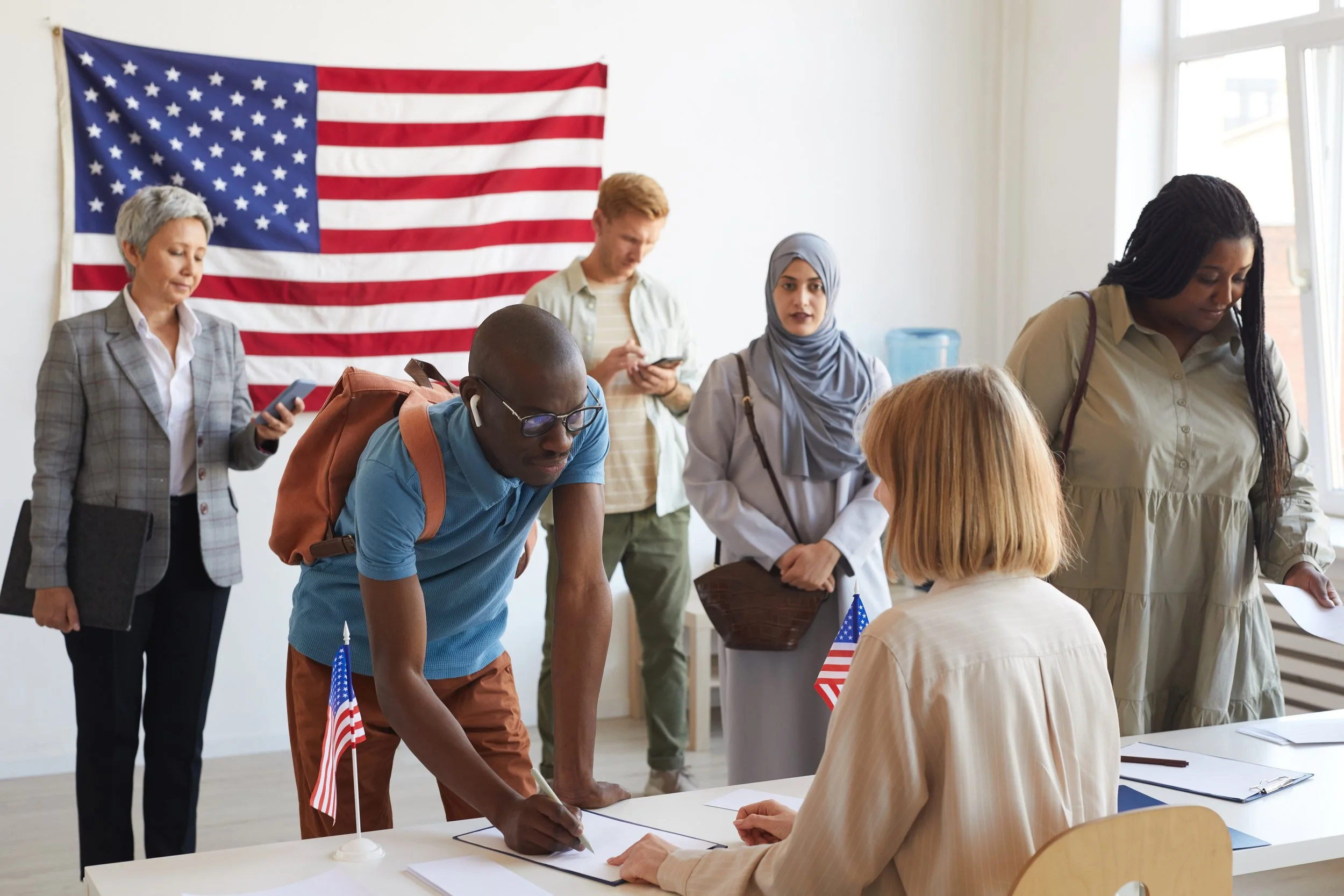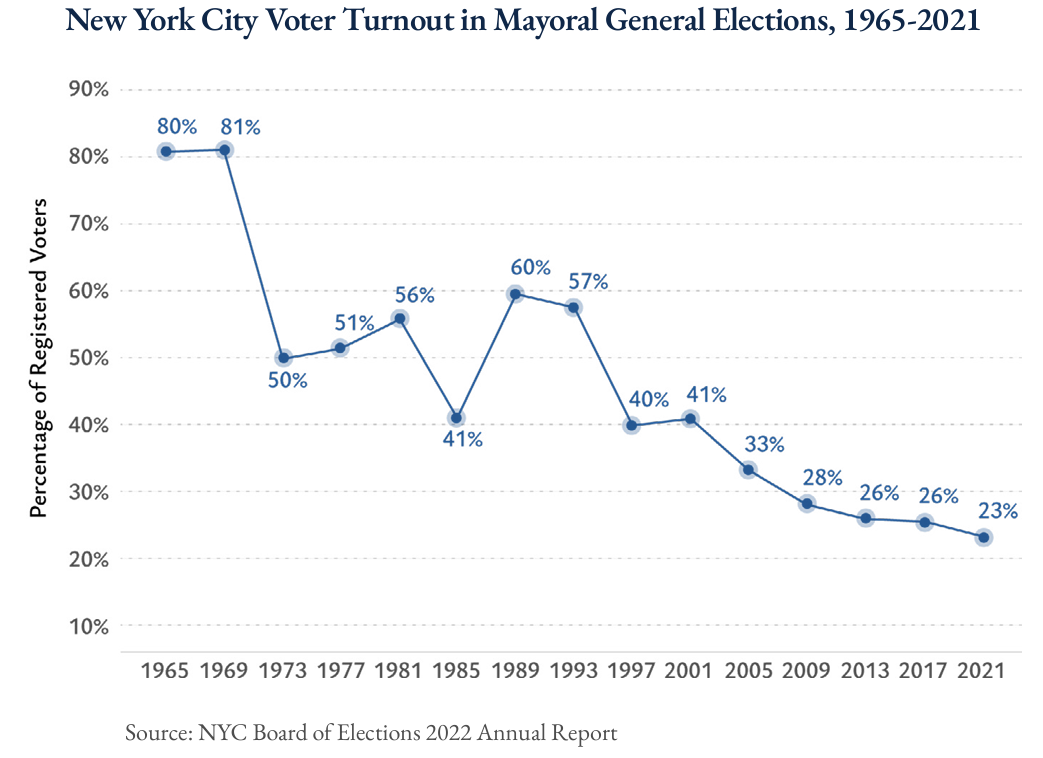Get Out the Vote in NYC’s General Election
By Alisa Orlowsky, Communications Associate
As New York City’s General Election approaches, we’re taking a closer look at the role of local government in NYC and the ways that community-based organizations can increase civic engagement in communities where voter turnout has historically been low.
If they haven’t already, in the coming weeks New Yorkers will be getting texts from campaign volunteers, knocks on doors, and flyers in their mailboxes. With New York City’s 2025 General Election right around the corner on November 4th, political candidates are at the peak of their campaigns, doing everything they can to make sure New Yorkers know what they stand for. The mayoral election has attracted the most attention and airtime, but it’s not the only position on the ballot. Voters will also get to choose their next City Comptroller, Public Advocate, Borough President, and City Council members, in addition to voting on 6 ballot measures.
Local government—comprising City Council, Mayors and their offices, borough presidents, and more— is the closest level of government to the people. They oversee public services, maintain infrastructure, and generally shape the policies that drive opportunity, growth, and quality of life in the communities they serve. The General Election is an opportunity for voters to signal to local elected officials what change they wish to see in the city. It provides valuable insights and has implications for the priority issues that the government will tackle. This feedback mechanism between community and local government is a prime example of civic engagement.
What is Civic Engagement?
Often heard in advocacy and good government circles, “civic engagement” is a broad term that refers to any “individual or collective action that seeks to enhance the well-being of individuals, families, and communities.” At its best, strong civic engagement empowers New Yorkers to understand and use their knowledge of local government processes, along with their awareness of community needs, to identify issues and solutions that can be addressed at the local government level.
The power of local government in NYC
For the last several summers, Summer Streets has created car-free zones for people to run, bike, walk, gather, and play across more than 400 blocks in the five boroughs. Year round, similar Open Streets programming operates in many parts of the city, turning streets into public spaces everyone can enjoy.
The process of organizing and operating Open Streets illustrates how local government works in NYC, bringing together city leaders from Mayor to City Council. NYC Votes breaks down the path to approval:
Learn about the distinct responsibilities of each of the city offices here.
NYC General Election Voter Turnout in Recent Years Leaves Room for Improvement
The power of voting is only as strong as the number of people who turn out. In 2021, only 1 million out of 4.7 million registered voters voted in the mayoral election—that means a staggering 77 percent of registered voters did not participate. Looking at data from 1965-2021, the voter turnout has drastically declined over time.
Further, voter turnout among eligible voters was lowest for the 18-29 age group in the 2021 mayoral election (11.1 percent). This was also true in elections before the pandemic: only 13.4 percent of eligible voters 18 to 29 voted in the 2017 NYC mayoral election. Turnout varies greatly by neighborhood, too. The borough with the lowest turnout percentages in the 2021 general election was the Bronx, with a turnout of 28 percent of eligible voters.
When voter turnout is especially low in certain communities, it creates underrepresentation for those groups among elected decision-makers and reduces visibility of the issues important to them; this goes against the core civic engagement and local government goals of serving all communities. Efforts to strengthen civic engagement through voter education and higher voter turnout should prioritize reaching the groups that are most underrepresented in general elections.
In New York, there already is a strong network that has a finger on the pulse of communities across the city. Community-based organizations are not-for-profit, often small, local entities that provide services from healthcare to job placement to everything in between; it’s common for local governments, like NYC’s, to fund these organizations to provide critical social services. They have established trust with community members by building close relationships with them. In turn, these organizations are knowledgeable both about the issues facing their communities and the approaches and strategies that might work to resolve them. With these insights, these organizations are well-positioned to advance civic engagement initiatives, including efforts to bolster voter turnout.
Bringing Civic Engagement Strategies to Life: The Civic Engagement Fellowship
Community-based organizations that serve Bronx residents can help uplift their voices with efforts to increase participation in local elections. To this end, CUNY ISLG and the New York City Campaign Finance Board (NYCCFB) partnered to create a two-year fellowship program, the Civic Engagement Fellowship (CEF), developed to build the power of local communities and increase knowledge, transparency, and participation in the democratic process.
In the CEF’s first cohort, which launched this summer, CUNY student fellows are embedded within 14 Bronx-serving CBOs to learn about and engage with the communities they serve. In partnership with the CBOs, Fellows will help design and implement civic engagement initiatives that meaningfully bring community members’ voices to the political conversation.
One of the CBOs, We Stay/Nos Quedamos, joined as a CEF host because they’ve seen how civic engagement “empowers residents to have a voice in the decisions that impact their lives, strengthens local leadership, and drives grassroots solutions to systemic challenges.”
“We've seen residents come together to advocate for affordable housing, improved public spaces, and greater access to local resources. Through community meetings, voter registration drives, and participatory planning processes, neighbors are not just passive recipients of services—they’re active contributors to the future of the South Bronx. This engagement has led to safer streets, stronger neighborhood coalitions, and the successful implementation of programs that reflect the true needs and values of the community.
When people are engaged, communities are transformed—from the ground up," shared Dr. Mark Gonzalez, Deputy Director at We Stay/Nos Quedamos.
“Through community meetings, voter registration drives, and participatory planning processes, neighbors are not just passive recipients of services—they’re active contributors to the future of the South Bronx. This engagement has led to safer streets, stronger neighborhood coalitions, and the successful implementation of programs that reflect the true needs and values of the community.”
- Mark Gonzalez, Deputy Director at We Stay/Nos Quedamos
Shaping the future of local government together
When policies, programs, and initiatives are drafted by elected officials that represent and understand their communities, local government becomes the foundation of democracy it was intended to be. Fostering civic engagement in communities with low voter turnout is therefore a vital endeavor for local government, particularly one that seeks to advance the well-being of everyone, no matter their background or zip code.
In New York, it’s crucial for local government leaders to acknowledge that low voter turnout in the Bronx makes it more difficult to represent residents’ needs, which has cascading effects on quality of life and trust in government. Actively funding and assessing civic engagement programs can increase voter turnout; community-based organizations, like the ones participating in the CEF, can connect community members with valuable voter information and resources that are tailored to the Bronx community.
As the NYC General Election quickly approaches, efforts to boost civic engagement are especially important. But civic engagement shouldn’t be a means to an end once every election cycle. Once the election is decided, civic engagement programming should continue in other forms to build lasting connections between communities and their local elected officials to create deeper conversations, more impactful policy, and better communities in service of all.
Photo by Seventyfour on Adobe Stock


